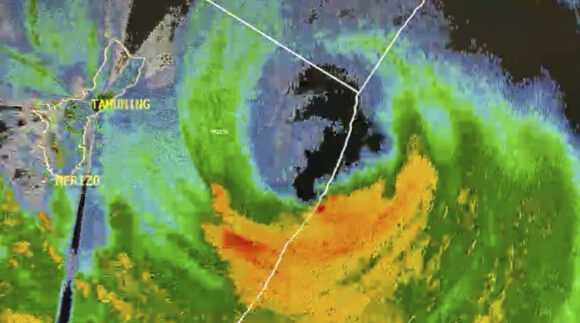HONOLULU (AP) – Typhoon Mawar barreled into Guam as a powerful Category 4 storm Wednesday, pummeling the U.S. Pacific territory with high winds, heavy rains and a dangerous storm surge that swamped low-lying areas as residents hunkered down in homes and shelters.
The typhoon’s center passed over the northern tip of Guam on Wednesday evening, the National Weather Service said. It is the strongest storm to hit the U.S. Pacific territory of over 150,000 people in decades.
The weather service earlier warned of a “triple threat” of winds, torrential rains and life-threatening storm surge, and officials were bracing for “considerable damage” including non-reinforced concrete walls being blown down, fuel storage tanks rupturing and overturned cars.
The weather service said the storm was a Category 4 “super typhoon,” meaning maximum sustained winds of 150 mph (241 kph) or greater.
The storm’s center hit Guam around 9 p.m. Wednesday, which is Wednesday morning in the continental United States. Guam lies west of the International Date Line and is ahead of the U.S. mainland and Hawaii, which is 3,800 miles (6,115 kilometers) to the east. Manila, the Philippine capital, is 1,600 miles (1,575 kilometers) to the west.
The weather service warned of an extremely dangerous and life-threatening situation said people should take cover and remain in shelter for the next few hours.
Earlier, the U.S. military sent away ships, President Joe Biden approved an emergency declaration and anyone not living in a concrete house was urged to seek safety elsewhere.
Residents were warned to stay inside and away from windows. The weather service also advised them not to go outside even if there was calm as its wide eye passed overhead: “Extreme winds will rapidly return.”
Electricity and water may be unavailable for days and perhaps weeks, forecasters said.
“The landscape is going to look different,” said Ken Kleeschulte, a lead meteorologist with the weather service in Tiyan, Guam. “The buildings will still be there, for the most part.”
That’s because since 2002, building codes have been updated to require homes be made of concrete. Some older, less robust residences fashioned from wood with tin roofs will likely be gone, Kleeschulte said.
Residents accustomed to typhoons had been preparing for days, filling up gas tanks, securing patio furniture and gathering important documents.
Officials warned that uprooted trees could block roads, cutting off residential areas for days or weeks, and could also be turned into deadly, flying projectiles.
“A lot of folks are keeping their eyes on trees,” Reuel Drilon, a resident of the southern village of Agat, said earlier Wednesday. “We expect a lot of foliage damage. Everyone here has a mango tree.”
Guam is a crucial hub for U.S. forces in the Pacific, and the Department of Defense controls about a third of the island. Rear Adm. Benjamin Nicholson, Joint Region Marianas commander, authorized the evacuation of defense personnel, dependents and employees in areas expected to be affected.
All ships were moved out to sea as a standard precaution, according to the Navy, and any personnel remaining on the island were sheltering in place. About 6,800 U.S. service members are assigned to Guam, according to the Pentagon.
Typhoon season runs from July 1 to Dec. 15 in the western North Pacific, according to the weather service.
About the photo: In this image taken from live a satellite video from the U.S. National Weather Service Guam, Typhoon Mawar is seen on radar at a press conference by the National Weather Service in the U.S. Pacific territory of Guam as the storm approached landfall, on Wednesday, May 24, 2023. (U.S. National Weather Service Guam via AP)
Was this article valuable?
Here are more articles you may enjoy.


 Hilcorp Fined $9.4 Million for Emissions of Methane and Volatile Gases
Hilcorp Fined $9.4 Million for Emissions of Methane and Volatile Gases  Progressive to Pay Policy Limits in Fatal Boat Crash That Involved Murdaugh’s Son
Progressive to Pay Policy Limits in Fatal Boat Crash That Involved Murdaugh’s Son  What It Really Means When a 1-in-1,000-Year Rainstorm Hits
What It Really Means When a 1-in-1,000-Year Rainstorm Hits  Claims Confirm Hundreds of Israeli Buildings Marred by Iran’s Attack
Claims Confirm Hundreds of Israeli Buildings Marred by Iran’s Attack 